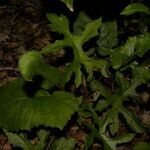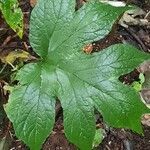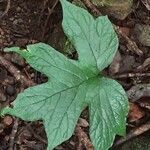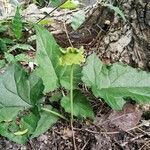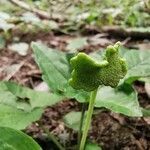Stem (partly) subterraneous, 3-14 mm thick. Leaves rosulate; stipules triangular to ovate, 0.2-0.6 cm long; petiole 3-20 cm long; blade chartaceous, broadly ovate to cordiform to subhastate, 4-25 x 3.5-30 cm, entire or pinnately to subpalmately or subpedately incised, apex acute, base cordate to acute, margin crenate-dentate to subentire, usually scabrous, hirtellous to strig(ill)ose above, puberulous on the veins beneath; secondary veins 3-7 pairs. Inflorescences green or with a purplish margin; peduncle 5-30 cm long; receptacle discoid, quadrangular to more or less irregularly lobed, (0.5-)1.5-2 cm in diam. Endocarp body tuberculate.
A herb. A small evergreen plant that keeps growing from year to year. It has a creeping rhizome or underground stem. This produces a ring of leaves o long leaf stalks. Leaves may or may not have lobes. The leaves are 20 cm long and the leaf stalks are 25 cm long. The crushed plant exudes a white latex. The flowers are separately male and female and small. The fruit are small and in a 4 sided container. The seeds are released explosively.
Succulent or subsucculent acaulescent or subacaulescent herbs. Leaves densely crowded, long-petioled, of relatively small or moderate size, extremely variable in dimensions and outline, commonly deeply pinnatifid, basifixed, usually scabridulous or inconspicuously puberulent. Receptacles on rather long slender peduncles, centrally peltate, variously radiate to nearly quadrangular, accrescent in fruit to as much as 5 cm. in diameter.
Herbs , to 4.5 dm. Stems covered with persistent petiole bases. Leaves: stipules persistent; petiole 8-25 cm. Leaf blade oblong-ovate, deltate-ovate, or orbiculate, entire or deeply pinnately lobed, 6-20 × 7-22 cm, pubescent. Inflorescences: peduncle 7-25 cm; receptacle flat, curved, or undulate, quadrangular or lobed, to 3.5 cm square. Drupes somewhat globose. Seeds yellowish, explosively expelled. 2 n = 30.
